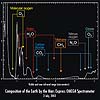| . |  |
. |
for Astrobiology Magazine Moffett Field CA (SPX) Jul 16, 2004 The AURA satellite was launched successfully into orbit early Thursday, on its mission to study the Earth's atmosphere, climate change and regional differences in air quality, NASA said. After four technical delays and a month-long wait from its original launch date in mid-June, a towering Boeing Delta II rocket blasted from Vandenberg Air Force Base in California, lifting the 2,967-kilogram (6,542-pound) satellite into the night sky at 3:02 am (1002 GMT). Less than half-an-hour later, the rocket separated from the satellite and the second-stage rocket ignited to take AURA to its orbit path at 704 kilometers (438 miles) altitude.
Mission To Planet Earth Continues... "The atmosphere is one of the most important and limited resources that we have," says Phil DeCola, Aura program scientist at NASA Headquarters in Washington D.C. "The kind of global coverage that we're going to get on almost a daily basis from all these instruments (on Aura) is unprecedented." Aura has four instruments to measure ozone and trace atmospheric gases: the Microwave Limb Sounder (MLS), the High Resolution Dynamics Limb Sounder (HIRDLS), the Tropospheric Emission Spectrometer (TES), and the Ozone Monitoring Instrument (OMI). These instruments will track climate change, and also monitor the ozone layer. The "ozone hole" is actually a thinning of the ozone layer over Antarctica. Pollutants such as Chlorofluorocarbons (CFCs) deplete the ozone layer, although international agreements like the Montreal Protocol have banned such chemicals. Aura will determine if the treaties are effective by detecting global levels of CFCs and their byproducts, chlorine and bromine, that destroy the ozone layer. Aura also will track regional and global air quality, detecting gases that create smog and ozone. When ozone exists in the lower atmosphere, the troposphere, it acts as an air pollutant. "We live in one atmosphere," says Mark Schoeberl, Aura project scientist at NASA's Goddard Space Flight Center in Maryland. "That one atmosphere contains pollutants which are pushed into the atmosphere by industrialized nations, by biomass burning in the tropics, by agricultural activity. Those pollutants float downstream, and you and I are breathing someone else's exhaust gases." Aura will work in cooperation with other satellites, which will all fly in formation to get a more comprehensive view of the planet. Dubbed the "A-train," the Aqua satellite, which monitors water quality, will lead the pack. Aqua will be followed by Calypso, due to be launched next year. Cloudsat and the French satellite Parasol will follow Calypso, and Aura will head up the rear. Schoeberl says that using the new technologies of Aura to study the Earth could lead to technologies that will study other planetary atmospheres. Earth is the only planet that we know of that has life, and Aura could help us better understand the close relationship life has with a planetary atmosphere. Life on Earth is not only dependent on the planet's atmosphere, it interacts with it and can even change it over time. "Bacteria started probably 2 billion years ago making oxygen in an atmosphere that had none. We're altering it even further," says Schoeberl. "So in the exploration of the universe, developing the technologies and precise instruments to look at the atmosphere is going to help. (Aura) is a technological stepping stone for the exploration of the solar system."
Related Links Aura at GSFC TerraDaily Search TerraDaily Subscribe To TerraDaily Express  Moffet Field CA (SPX) Jul 12, 2004
Moffet Field CA (SPX) Jul 12, 2004A powerful new instrument heading to space this week is expected to send back long-sought answers about greenhouse gases, atmospheric cleansers and pollutants, and the destruction and recovery of the ozone layer.
|
| ||||||||||
| The content herein, unless otherwise known to be public domain, are Copyright 1995-2016 - Space Media Network. All websites are published in Australia and are solely subject to Australian law and governed by Fair Use principals for news reporting and research purposes. AFP, UPI and IANS news wire stories are copyright Agence France-Presse, United Press International and Indo-Asia News Service. ESA news reports are copyright European Space Agency. All NASA sourced material is public domain. Additional copyrights may apply in whole or part to other bona fide parties. Advertising does not imply endorsement, agreement or approval of any opinions, statements or information provided by Space Media Network on any Web page published or hosted by Space Media Network. Privacy Statement All images and articles appearing on Space Media Network have been edited or digitally altered in some way. Any requests to remove copyright material will be acted upon in a timely and appropriate manner. Any attempt to extort money from Space Media Network will be ignored and reported to Australian Law Enforcement Agencies as a potential case of financial fraud involving the use of a telephonic carriage device or postal service. |